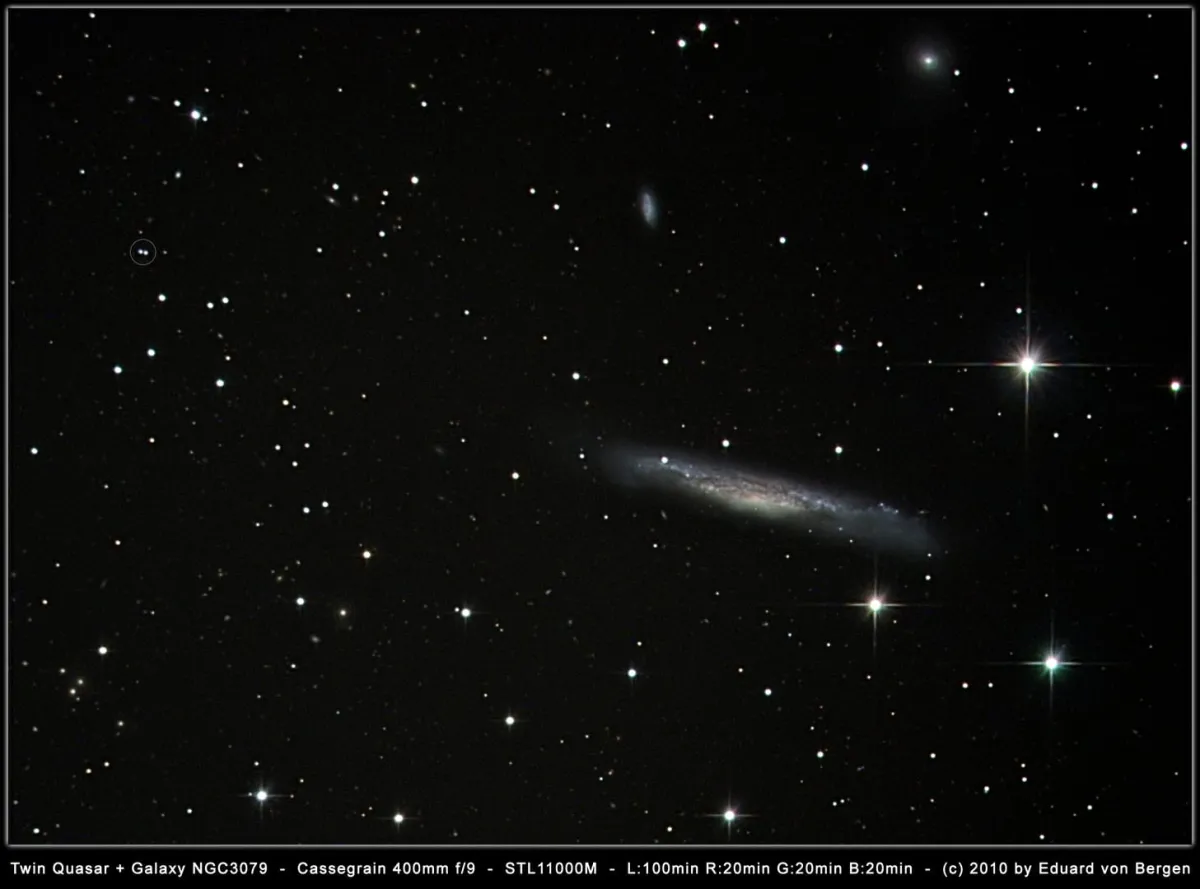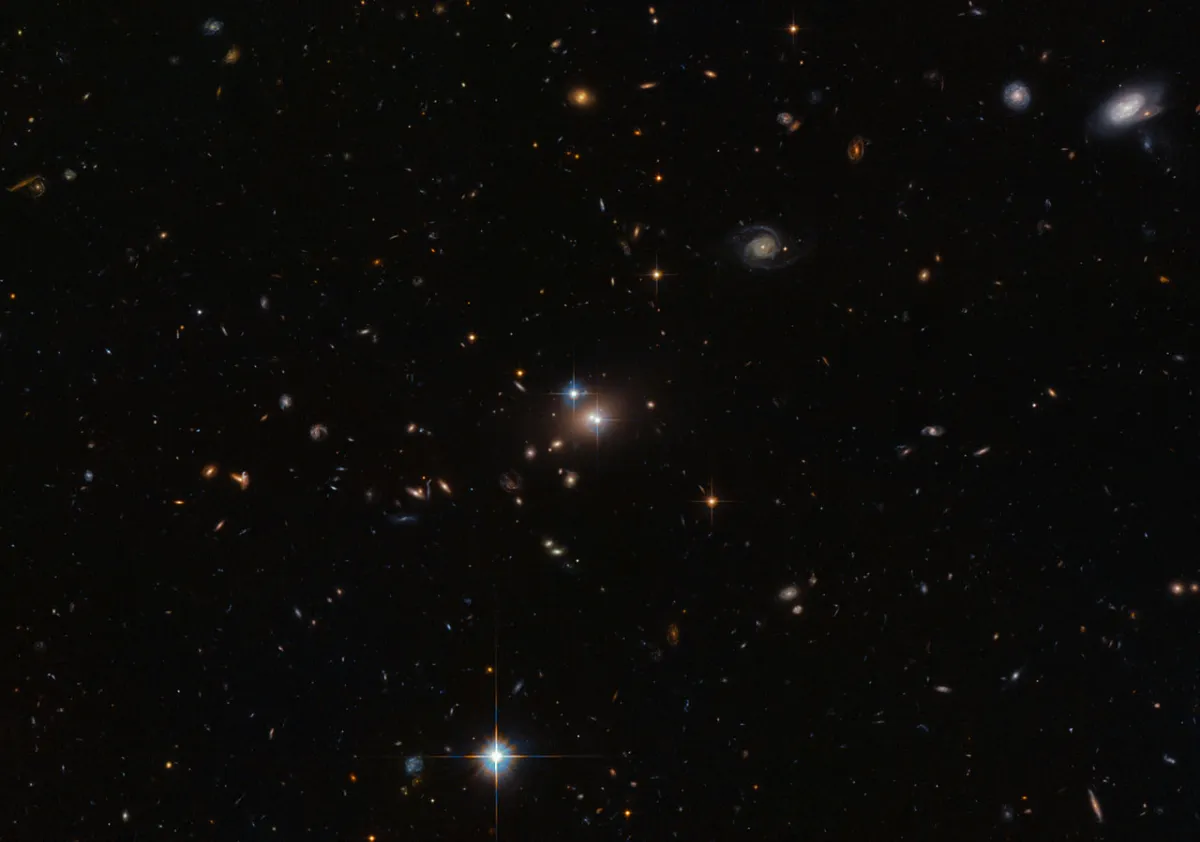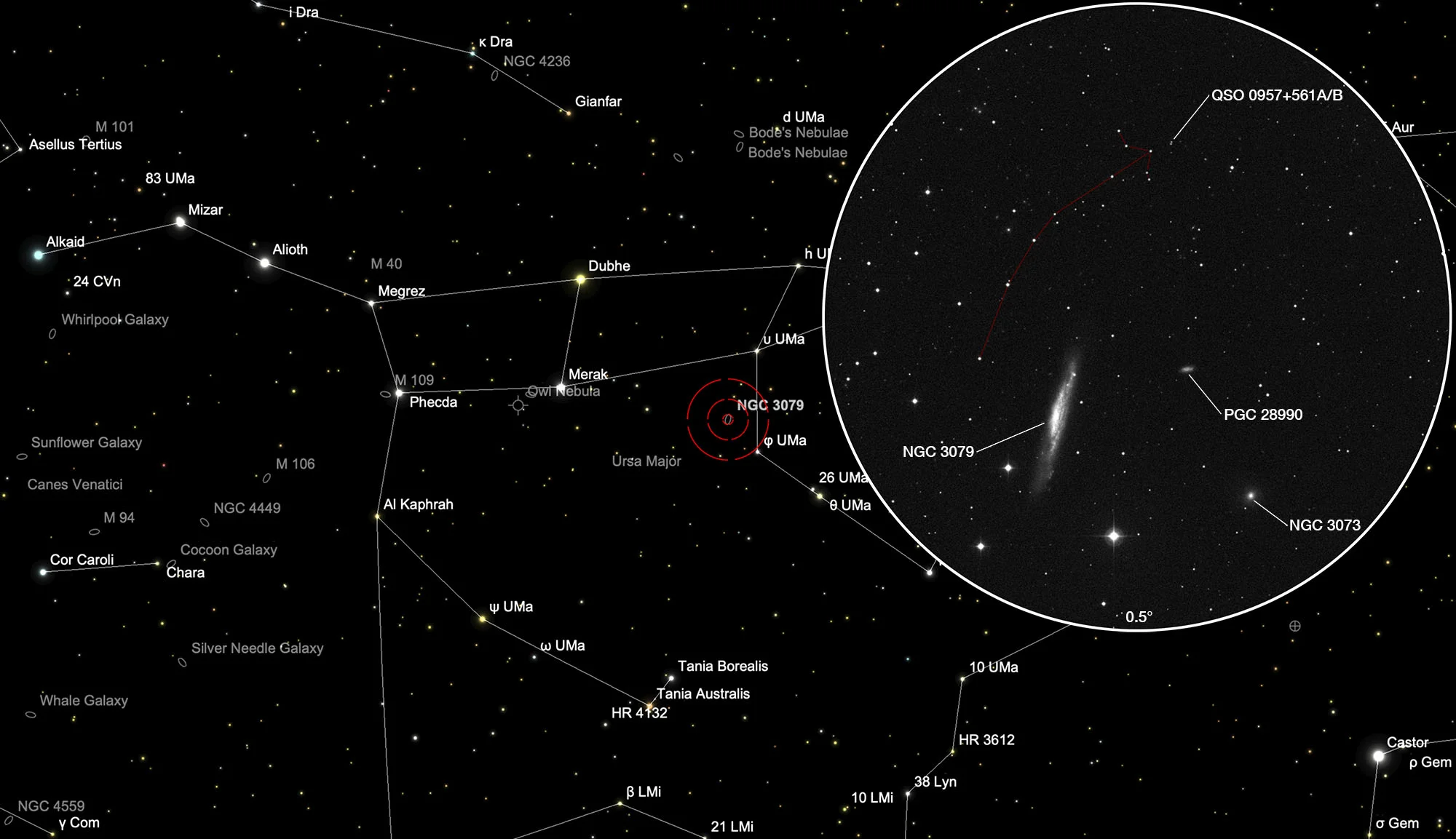Twin Quasar (QSO 0957+561A/B)

Object Description
The two quasars QSO 0957+561A/B, also known under the name «Twin Quasar» were first discovered in 1979 using a radio telescope and then also on photographic plates. The twins quickly attracted the attention of professional astronomers, as they are one of the first visible proofs of a gravitational deflection of light, as described by Albert Einstein in his 1915 general theory of relativity.
We see the quasar twice because its light is deflected by the gravitational field of a large, faint foreground galaxy (not NGC 3079!) on its way to Earth in such a way that that of the southern component B makes a small detour of about one light year. The lensing galaxy is closer to the southern component B. If this galaxy were not present, we would only see a single image of the quasar, weaker by about half a magnitude.
The two single images A and B are separated by six arc seconds. The apparent brightness varies around 0.1 mag per month and around 16.4 mag. The highlight of the matter: Due to the different light paths that the two images cover to us, fluctuations in brightness of the northern component A reach us about a year before those of the southern component B.

At a distance of around five billion light-years, the quasar is by far the most distant thing visible with an amateur telescope with a mirror diameter of up to 500 mm. The light left the quasars before our solar system and the earth (about 4.6 billion years ago) formed! [99]
| Name | QSO 0957+561A |
| Object Type | Quasar |
| Right Ascension (J2000.0) | 10h 01m 21s |
| Declination (J2000.0) | +55° 53' 56" |
| Parallaxes | 0.0483 mas |
| Radial velocity | 211972 km/s |
| Redshift z | 1.414 |
| Magnitudes | B 17.16; V 16.95; G 17.108419; u 17.2251; g 17.1134; r 16.9234; i 16.8075; z 16.8607 |
| Identifiers | 1E 0957+56.1; 1E 0957.9+5607; 1E 0957.9+5608; 1RXS J100121.5+555351; 6C 095757+560821; 7C 095757.60+560823.00; 87GB 095758.5+560808; 8C 0958+561; BWE 0957+5608; EQ 0957+56; FIRST J100121.1+555357; GB6 B0957+5608; GB6 J1001+5553; Gaia DR2 1045166002126206848; Gaia DR3 1045166002126206848; IERS B0957+561; ILT J100121.03+555355.9; KODIAQ J100120+555355; NAME Twin Quasar; NVSS J100121+555355; QSO B0956+56A; QSO B0957+5608A; QSO B0957+561; QSO B0957+561A; QSO J1001+5553; QSO J1001+5553A; RGB J1001+558A; RGB J1001+558C; RGB J1001.4+5553; RIXOS 252-31; RX J1001.3+5553; RX J100120.3+555349; SBSS 0957+561; SDSS J100120.68+555355.9; SDSS J100120.69+555355.6; TXS 0957+561; VLSS J1001.3+5553; WB 0957+5608; WISE J100120.68+555355.4; WISEA J100120.68+555355.4; WN B0957.9+5608; YGKOW 83; [BDW2002] q0957+5608a; [HB93] 0957+561A; [RGH85] A; [VV2000] J100120.8+555354; [VV2003] J100120.8+555354; [VV2006] J100120.8+555354; [VV2010] J100120.8+555354; [VV96] J100120.8+555354; [VV98] J100120.8+555354; [ZEH2003] RX J1001.3+5553 1 |
| PGC | RA | Dec | Type | Dim | Btot | HRV | PA | Names |
|---|---|---|---|---|---|---|---|---|
| PGC 28974 | 10 00 51.9 | +55 37 13 | LB | 1.2 x 1.1 | 14.0 | 1216 | NGC 3073, UGC 5374, MCG 9-17-7, MK 131, CGCG 266-6, CGCG 265-54 | |
| PGC 28990 | 10 01 05.2 | +55 44 33 | .8 x .3 | 14.7 | 3952 | MCG 9-17-9, CGCG 266-7, CGCG 265-55 | ||
| PGC 29050 | 10 01 58.2 | +55 40 42 | SB | 8.1 x 1.3 | 11.5 | 1124 | 165 | NGC 3079, UGC 5387, MCG 9-17-10, CGCG 266-8, IRAS 9585+5555 |
Signpost to the Twin Quasar
The objects Q0957+561A and B, known as twin quasar, are located in Ursa Maior. On 18 February it is in opposition to the Sun and crosses the meridian at local midnight. Finding it is made much easier by the nearby and quite prominent foreground galaxy NGC 3079 (it has nothing to do with gravitational lensing). This is located at RA 10h 02.0m and Dec +55° 41' (A2000.0). The apparent magnitude is 11.2 mag, the size 7.6' x 1.7'. It is a Sb spiral seen almost from the edge. In the 50 cm telescope it appears quite bright. The twin quasar is only 10 arc minutes north of this beautiful galaxy
To identify the quasar from the surrounding stars, use the 30 arc minutes section from the STScI Digitized Sky Survey [160]
Visual Observation
300 mm aperture: The position of the quasar can be reliably identified in just a few minutes using the finder charts. Even under moderate viewing conditions, the small Y-shaped asterism of four 14th magnitude stars is quickly and easily identifiable in a 300 mm f/4 Newton. The quasar itself can only be recognized after a long period of observation using averted vision, but cannot yet be separated. The observation needs to be checked again on a better night in a darker place. — 1997, Bernd Nies
350 mm aperture: With a Dobsonian of 14 inch or 350 mm lens diameter you are at the instrument limit, a larger aperture is definitely helpful. It then took about 1.5 hours until I believed my multiple short quasar sightings. With high magnifications I tried one to get as good and deep black sky background as possible. The object then also appeared occasionally for fractions of a second. In any case, a confirmation of the quasar in a larger instrument was still pending. — 14" PWO-Dobson, F:4.6 / TV-Nagler-Zoom 6mm-5mm, 266x-320x, 0.19°-0.16°, 2004, Eduard von Bergen
400 mm aperture: This confirmation was achieved with a 16 inch or 400 mm Ninja Dobsonian. Even with such an instrument, the quasar was a real challenge. It showed up more often than in the 14-incher, each time flashing briefly. Indirect vision and good breathing helped. In the 16 inch the perception of the quasar was clearer and more definite. We assured each other of the sighting of the quasar. Almost euphorically we switched to observing simpler and closer objects. — 16" Ninja-Dobson, F:4.5 / TV-Radian 6mm, 300x, 0.2°, 2004, Eduard von Bergen

500 mm aperture: On 20 February 1995 I found the double quasar very quickly by «star hopping» from NGC 3079. I used an ST6 camera on our 50 cm telescope (configured as a Newton with a focal length of 2.5 m). It showed the quasar as remarkably bright stars with an integration time of only 20 seconds, and they were clearly resolved. The angular distance of the objects is only 6 arc seconds, which corresponded to around three pixels. I exposed several CCD exposures with an integration time of up to 10 minutes. The seeing was around 1.5 to 2 arc seconds. The sky was relatively transparent. Since the object was almost exactly at the zenith at the end of the series of recordings, the eyepiece of the CCD camera was out of range, so that for the time being I refrained from looking for the quasars visually. According to the literature, they should be visible in a 20-incher, possibly even separate. I tried to take brightness measurements on the CCD images. This is made somewhat difficult by the small angular distance between the two objects. My provisional values for 02/20/1995 are 17.2 mag for the A component and 16.9 mag for B. The faintest, still reliably photometric stars on the deepest exposure have 19.5 mag. — 1995, Jürg Alean

762 mm aperture: The galaxy NGC 3079 is the starting point and the other memorable star patterns point the way to the twin quasar. At 5 billion light years, this lies at least a third deep in the 13.5 to 14.5 billion year old universe. The quasar could be seen directly and indirectly by eye. For further documentation, we also took a short exposure photo, whereby we could not separate the twin quasar from the eye or the photo because of the modest seeing. — 30" SlipStream-Dobson f/3.3, Hasliberg, 31. 12. 2021, Eduard von Bergen
